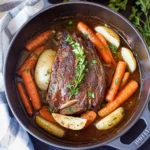Description of this recipe: Persian Jeweled Rice, also known as Morassa Polow, is a stunning and flavorful dish that elevates ordinary rice to a celebratory centerpiece. This recipe combines the delicate aroma of basmati rice with the vibrant colors and textures of dried fruits, nuts, and fragrant spices. The saffron infusion adds a golden hue and a subtle floral note, making it a feast for both the eyes and the palate. Each bite is an explosion of flavors, from the sweet tartness of cherries and apricots to the earthy warmth of cinnamon and cardamom. This dish is perfect for special occasions, holidays, or any time you want to impress your guests with a truly unique and memorable culinary experience. It’s a symphony of tastes and textures that captures the essence of Persian cuisine.
Why you will love this recipe: You’ll fall in love with Persian Jeweled Rice for its exquisite blend of flavors and textures. The aromatic basmati rice, infused with saffron, creates a fragrant base that perfectly complements the sweet and tangy dried fruits. The toasted nuts add a delightful crunch, while the spices create a warm and inviting aroma that fills your kitchen. This dish is not only delicious but also visually stunning, making it an impressive addition to any table. It’s surprisingly easy to make, and the result is a sophisticated and elegant dish that will impress even the most discerning palates. Whether you’re a seasoned cook or a beginner, this recipe is sure to become a favorite. The combination of sweet, savory, and aromatic elements makes it an unforgettable culinary experience.
Introduction Persian Jeweled Rice, or Morassa Polow, is a culinary masterpiece that showcases the artistry and elegance of Persian cooking. This dish is more than just rice; it’s a celebration of flavors, colors, and textures that come together to create a truly unforgettable experience. The origins of Jeweled Rice can be traced back centuries, to a time when Persian cuisine was at the height of its sophistication. This dish was often served at royal banquets and special occasions, symbolizing wealth, abundance, and prosperity. The use of saffron, a precious spice derived from the Crocus flower, adds a golden hue and a delicate floral aroma that is characteristic of Persian cuisine. The dried fruits and nuts, each carefully selected for their unique flavors and textures, represent the diverse bounty of the Persian landscape. The combination of sweet, tangy, and savory elements creates a harmonious balance that is both satisfying and intriguing.
In this recipe, we’ll guide you through the steps of creating your own Persian Jeweled Rice, using simple techniques and readily available ingredients. Whether you’re an experienced cook or a beginner, you’ll find this recipe easy to follow and immensely rewarding. Get ready to embark on a culinary journey that will transport you to the heart of Persia, where food is an art form and every meal is a celebration. This dish is perfect for impressing guests, adding a touch of elegance to a holiday meal, or simply treating yourself to a truly special culinary experience.
Ingredients:
US Customary | Metric
- 1/2 tsp saffron threads
- 2 Tbsp olive oil or butter
- 1/4 tsp fennel seeds
- 1/4 tsp cumin seeds
- 1/4 tsp cinnamon
- 1/4 cardamom
- 1/4 tsp allspice
- 1 medium onion, diced
- 1 1/2 cups basmati rice, rinsed well
- 2 bay leaves
- finely julienned rind of 1 lemon
- 1/4 cup dried tart cherries
- 1/4 cup dried Turkish apricots, diced
- 1/4 cup dried figs, diced
- 1/4 cup slivered almonds, toasted
- 1/4 cup pistachios, toasted
- seeds of 1 pomegranate for garnish
Preparation:
Step 1: Prepare the Saffron Infusion In a small bowl, mix the saffron threads with 2 1/4 cups of hot water. Allow the saffron to steep for at least 20 minutes to release its color and aroma. This infusion will be used to cook the rice, imparting a beautiful golden hue and a delicate floral flavor. Note: For an extra layer of flavor, you can substitute vegetable or chicken stock for the water. The stock will add depth and richness to the dish.
Step 2: Sauté the Spices and Onion In a large skillet or pot, melt the butter or olive oil over medium-low heat. Add the fennel seeds and cumin seeds and sauté for about a minute or two, until they become fragrant. Be careful not to burn the spices, as this will result in a bitter taste. Next, add the cinnamon, cardamom, and allspice, and stir to combine. Add the diced onion and sauté over low heat until the onion is softened and translucent, about 10 minutes. Sautéing the onion slowly will bring out its natural sweetness and enhance the overall flavor of the dish.
Step 3: Add the Rice and Toast Lightly Add the rinsed basmati rice to the skillet with the spices and onion. Sauté the rice for a minute or two, stirring constantly, to lightly toast it. This step helps to enhance the flavor of the rice and prevent it from becoming mushy during cooking. Ensure that each grain is coated with the fragrant mixture.
Step 4: Combine and Simmer Pour in the saffron-infused water (or stock) along with the bay leaves and lemon rind. Stir to combine, ensuring that all the ingredients are evenly distributed. Season with salt and freshly cracked black pepper to taste. Bring the mixture to a gentle simmer, then add in the dried cherries, apricots, and figs. Stir to combine, and then cover the skillet with a tight-fitting lid. Reduce the heat to low and cook for about 12 minutes.
Step 5: Rest and Fluff After 12 minutes, check the rice to see if it is tender and has absorbed most of the liquid. If it’s not quite done, let it cook for a few more minutes, checking periodically to ensure it doesn’t burn. Once the rice is cooked, turn off the heat and let it sit, covered, for another 10 minutes. This resting period allows the rice to fully absorb the remaining moisture and become perfectly fluffy. Finally, remove the lid and fluff the rice gently with a fork. Remove the bay leaves and lemon rind before serving.
COOKING Rating: 5/5
Serving Suggestions: Persian Jeweled Rice is a versatile dish that can be served as a main course or a side dish. It pairs beautifully with grilled meats, roasted vegetables, or vegetarian stews. For a truly authentic Persian meal, serve it alongside kebabs, such as chicken or lamb koobideh. It also complements dishes like Ghormeh Sabzi (herb stew) or Fesenjan (pomegranate walnut stew). Garnish the rice with additional toasted nuts and pomegranate seeds for an extra touch of elegance. This dish is also wonderful served at room temperature, making it a great option for picnics and potlucks.
Tips:
- Rinsing the rice thoroughly before cooking is essential to remove excess starch and prevent it from becoming sticky.
- Toasting the nuts before adding them to the rice enhances their flavor and texture.
- Use high-quality saffron for the best color and aroma.
- Adjust the amount of dried fruits and nuts to your liking.
- For a vegetarian version, use vegetable stock instead of chicken stock.
- If you don’t have all the dried fruits on hand, feel free to substitute with others, such as cranberries or golden raisins.
- To prevent the rice from sticking to the bottom of the skillet, you can add a thin layer of oil or butter before adding the rice.
- If you prefer a sweeter dish, you can add a tablespoon or two of sugar to the rice while it’s cooking.
- This dish can be made ahead of time and reheated. Simply store it in an airtight container in the refrigerator and reheat in the microwave or oven before serving.
Prep Time: 25 minutes Cook Time: 22 minutes Total Time: 47 minutes
Nutritional Information: (per serving, approximate) Calories: 450 Protein: 10g Sodium: 150mg
Conclusion Persian Jeweled Rice is a culinary treasure that deserves a place in every home cook’s repertoire. Its vibrant colors, fragrant aromas, and delightful blend of flavors make it a truly special dish. Whether you’re celebrating a special occasion or simply want to add a touch of elegance to your everyday meals, this recipe is sure to impress. With its simple techniques and readily available ingredients, Persian Jeweled Rice is easy to make and endlessly customizable. So go ahead, embark on a culinary adventure and discover the magic of Persian cuisine!
5 Questions and Answers about this recipe:
Q1: Can I use different types of rice for this recipe? A: While basmati rice is traditionally used in Persian Jeweled Rice, you can experiment with other long-grain rice varieties. However, keep in mind that different types of rice may require different cooking times and liquid amounts. Basmati rice is preferred for its delicate aroma and fluffy texture, which complements the other ingredients perfectly.
Q2: Can I make this recipe ahead of time? A: Yes, Persian Jeweled Rice can be made ahead of time and reheated. Allow the rice to cool completely before storing it in an airtight container in the refrigerator. When ready to serve, reheat it in the microwave or oven until heated through. Add a tablespoon or two of water or broth to help keep the rice moist.
Q3: What if I don’t have all the dried fruits listed in the recipe? A: Feel free to substitute with other dried fruits that you enjoy. Cranberries, golden raisins, or chopped dates would all be excellent additions. The key is to use a variety of fruits with different textures and flavors to create a balanced and interesting dish.
Q4: How do I prevent the rice from sticking to the bottom of the skillet? A: To prevent sticking, make sure to use a skillet with a non-stick surface. You can also add a thin layer of oil or butter to the bottom of the skillet before adding the rice. Another tip is to avoid stirring the rice too much during cooking, as this can release starch and cause it to stick.
Q5: Can I add protein to this dish to make it a complete meal? A: Absolutely! Persian Jeweled Rice pairs well with a variety of proteins. Grilled chicken, lamb, or fish would all be delicious additions. You can also add cooked chickpeas or lentils for a vegetarian option. Simply add the protein to the skillet during the last few minutes of cooking, or serve it alongside the rice.



